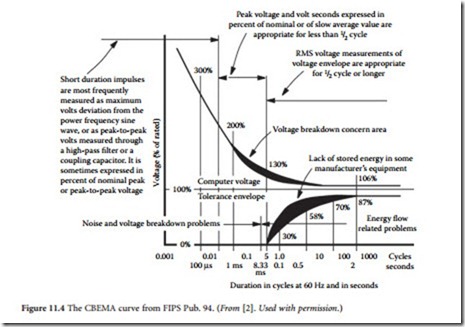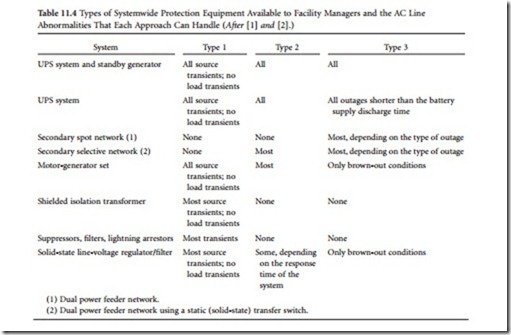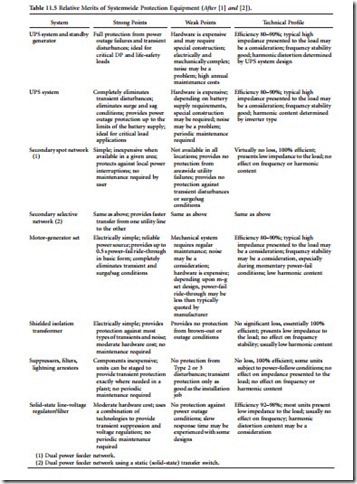Protection Alternatives
A facility can be protected from ac line disturbances in two basic ways: the systems approach or the dis- crete device approach. Table 11.4 outlines the major alternatives available:
• Uninterruptible power system (UPS) and standby generator
• UPS stand-alone system
• Secondary ac spot network
• Secondary selective ac network
• Motor-generator (m-g) set
• Shielded isolation transformer
• Suppressors, filters, and lightning arrestors
• Solid-state line-voltage regulator/filter
Table 11.5 lists the relative benefits of each protection method. Because each installation is unique, a thorough investigation of the facility needs should be conducted before purchasing any equipment. The systems approach offers the advantages of protection engineered to a particular application and
need, and (usually) high-level factory support during equipment design and installation. The systems approach also means higher costs for the end user.
Specifying System-Protection Hardware
Developing specifications for systemwide power-conditioning/backup hardware requires careful analysis of various factors before a particular technology or a specific vendor is selected. Key factors in this pro- cess relate to the load hardware and load application. The electrical power required by a sensitive load may vary widely, depending on the configuration of the system. The principle factors that apply to system specification include the following:
• Power requirements, including voltage, current, power factor, harmonic content, and transformer configuration
• Voltage-regulation requirements of the load
• Frequency stability required by the load, and the maximum permissible slew rate (the rate of change of frequency per second)
• Effects of unbalanced loading
• Overload and inrush current capacity
• Bypass capability
• Primary/standby path transfer time
• Maximum standby power reserve time
• System reliability and maintainability
• Operating efficiency
An accurate definition of critical applications will aid in the specification process for a given site. The potential for future expansion also must be considered in all plans.
Power requirements can be determined either by measuring the actual installed hardware or by checking the nameplate ratings. Most nameplate ratings include significant safety margins. Moreover, the load normally will include a diversity factor; all individual elements of the load will not necessarily be operating at the same time.
Every load has a limited tolerance to noise and harmonic distortion. Total harmonic distortion (THD) is a measure of the quality of the waveform applied to the load. It is calculated by taking the geo- metric sum of the harmonic voltages present in the waveform and expressing that value as a percentage of the fundamental voltage. Critical DP loads typically can withstand 5% THD, where no single harmonic exceeds 3%. The power-conditioning system must provide this high-quality output waveform to the load, regardless of the level of noise or distortion present at the ac input terminals.
If a power-conditioning/standby system does not operate with high reliability, the results often can be disastrous. In addition to threats to health and safety, there is a danger of lost revenue or inventory, and hardware damage. Reliability must be considered from three different viewpoints:
• Reliability of utility ac power in the area.
• Impact of line-voltage disturbances on DP loads.
• Ability of the protection system to maintain reliable operation when subjected to expected and unexpected external disturbances.
The environment in which the power-conditioning system operates will have a significant effect on reli- ability. Extremes of temperature, altitude, humidity, and vibration can be encountered in various appli- cations. Extreme conditions can precipitate premature component failure and unexpected system shutdown. Most power-protection equipment is rated for operation from 0 to 40°C. During a commer- cial power failure, however, the ambient temperature of the equipment room can easily exceed either value, depending on the exterior temperature. Operating temperature derating typically is required for altitudes in excess of 1000 ft.




